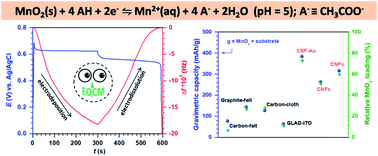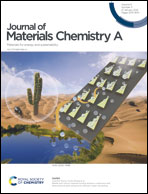Towards a high MnO2 loading and gravimetric capacity from proton-coupled Mn4+/Mn2+ reactions using a 3D free-standing conducting scaffold†
Abstract
We highlight 3D free-standing electrospun CNF electrodes as superior conductive scaffolds for the highly reversible proton-coupled MnIV(s) ↔ MnII(aq) conversion in a mild aqueous buffered electrolyte (pH 5). An electrochemical quartz crystal microbalance is used to in situ monitor these conversion reactions on the non-transparent CNF electrodes. Free-standing CNFs allow for a remarkably high relative MnO2 loading (63%, equivalent to an mMnO2/mCNF ratio of 1.7) at a maximal charge of 1.4 mA h cm−2, while keeping the C.E. ≥ 95% over 300 cycles. The gravimetric capacity of the complete cathode is thus as high as 338 mA h gMnO2+CNF−1 (i.e., 534 mA h gMnO2−1), outperforming the current state-of-the-art cathodes based on conventional graphite/carbon felts as substrates (<30% MnO2 loading, <0.4 mMnO2/mCNF ratio and <150 mA h gMnO2+substrate−1) or composite electrodes. Furthermore, the buffered electrolyte allows for remarkably highly constant deposition–dissolution potentials with a low hysteresis (0.16 V). Pairing 3D electrospun CNFs (diameter ≤ 200 nm) and mild aqueous buffered electrolytes is thus a striking approach towards the development of MnO2-based mild aqueous batteries with high energy efficiency.

- This article is part of the themed collection: Energy Frontiers: Electrochemistry and Electrochemical Engineering


 Please wait while we load your content...
Please wait while we load your content...